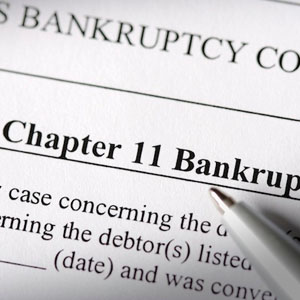Chapter 11
Chapter 11 of the Bankruptcy Code permits reorganization under the bankruptcy laws and is available to every business and individual, whether organized as a corporation, LLC, partnership, individual or business operated by an individual as a sole proprietorship. In Chapter 11, in most instances the debtor remains in control of its business operations or his/her assets as a debtor in possession, and is subject to the oversight and jurisdiction of the court.
 Chapter 11 affords the debtor in possession a number of mechanisms to restructure its business. A debtor in possession can acquire financing and loans on favorable terms by giving new lenders first priority on the business’ earnings. The court may also permit the debtor in possession to reject and cancel contracts. Debtors are also protected from litigation against the business through the imposition of an automatic stay. While the automatic stay is in place, creditors are stayed from any collection attempts or activities against the debtor in possession, and most litigation against the debtor is stayed, or put on hold, until it can be resolved in bankruptcy court, or resumed in its original venue.
Chapter 11 affords the debtor in possession a number of mechanisms to restructure its business. A debtor in possession can acquire financing and loans on favorable terms by giving new lenders first priority on the business’ earnings. The court may also permit the debtor in possession to reject and cancel contracts. Debtors are also protected from litigation against the business through the imposition of an automatic stay. While the automatic stay is in place, creditors are stayed from any collection attempts or activities against the debtor in possession, and most litigation against the debtor is stayed, or put on hold, until it can be resolved in bankruptcy court, or resumed in its original venue.
In a Chapter 11, unlike other chapters of the bankruptcy, no trustee is appointed to administer your case, unless the court orders otherwise. The debtor, as debtor-in-possession, will be allowed to act as its own trustee and manage its own business.
A Chapter 11 is commenced by filing a petition in a bankruptcy court that has jurisdiction over the individual or the business entity. Within 7 days after filing, a 7-day package must be filed with the U.S. Trustee. As a part of the requirement, all existing bank accounts must be closed, and all funds transferred to newly opened debtor-in-possession accounts (general, payroll, tax, cash collateral, etc.). Other required documents include, but are not limited to: proof of insurance, required certificate and licenses, financial statements, cash flow statements, etc.
Many first day motions also must be filed. If there is insider receiving salary, if there are pre-petition wages that need to be paid, if there is a cash collateral issue, if there are professionals that need to be employed, etc., a motion seeking court approval is required.
A chapter 11 is not just limited to big businesses seeking restructuring of its debts. Individuals, real estate projects, or small businesses can also take advantage of the court protection to reorganize their finances.
Individual Filing
For individuals, if the unsecured and/or secured debt exceeds the chapter 13 debt limits, and there is a need to reduce, consolidate, restructure or eliminate certain debts, or to stop a bank levy, garnishment, or foreclosure, Chapter 11 may be an option. It can also be employed to strip off a junior lien, avoid a judgment lien, negotiate tax lien, protect non-exempt properties, change the terms of a mortgage, extend the maturity date of a loan, or seek some other remedies not available in a chapter 13. This is sometimes referred to as a “jumbo 13.” The options you could have in an individual chapter 11 are much broader than what’s available in a chapter 7 or chapter 13.
Chapter 11 bankruptcy reorganization was originally intended for businesses, but the 1991 U.S. Supreme Court case Toibb v. Radloff held that non-business, individual consumers also are eligible. This is pursued by individuals who still have substantial personal earning potential but whose disposable income exceeds the limit set forth by Chapter 7 and/or debt limit set forth by Chapter 13.
An example of a non-business Chapter 11 bankruptcy filer might be a celebrity who just got in over his or her head with bad investments but who conceivably still has earning potential through product endorsements.
Another example might be someone who owns real property, but the secured debt exceeds the limit set forth by Chapter 13, and if there is enough equity in a real property.
Another example might be someone who has substantial non-exempt assets, but either the secured and/or unsecured debt exceed the limit of Chapter 13.
Small Business Filing
For businesses, there are variations on the types of Chapter 11s you could file. For businesses with debts less than $2,343,300, a small business filing may be in order. This is a more streamlined process because monthly reporting is easier, the disclosure statement and chapter 11 plan may be combined, etc.
Single Asset Real Estate
For real estate projects, one must first determine whether it is a Single Asset Real Estate as defined in 11 U.S.C. § 101 (51B). Single asset real estate is defined as “real property constituting a single property or project, other than residential real property with fewer than 4 residential units, which generates substantially all of the gross income of a debtor.” If a project is classified as Single Asset Real Estate, then a Chapter 11 plan must be filed within 90 days, or interest on the mortgage must be tendered right after filing to provide lender with adequate protection, among other things.
Business Filing
Chapter 11 bankruptcy is intended primarily for the reorganization of businesses with heavy debt burdens, most often associated with corporations. The goal of filing for Chapter 11 bankruptcy protection, versus Chapter 7, is to become profitable. To achieve this goal, the debtor’s first move is to renegotiate leases and contracts and either have debts discharged or partially repay them. Creditors have an incentive to work with the debtor and make compromises, since they generally would not get better terms in a Chapter 7 action. However, if the business is insolvent, meaning its debts exceed its assets, and the business is unable to pay debts as they come due, the bankruptcy restructuring may result in the company’s owners being left with nothing. As a result, the owners’ rights and interests are ended and the company’s creditors are left with ownership of the newly reorganized company.
Chapter 11 is typically used to reorganize a business, which may be a corporation, sole proprietorship, or partnership. A corporation exists separate and apart from its owners, the stockholders. The chapter 11 bankruptcy case of a corporation (corporation as debtor) does not put the personal assets of the stockholders at risk other than the value of their investment in the company’s stock. A sole proprietorship (owner as debtor), on the other hand, does not have an identity separate and distinct from its owner(s). Accordingly, a bankruptcy case involving a sole proprietorship includes both the business and personal assets of the owners-debtors. In a partnership bankruptcy case (partnership as debtor), however, the partners’ personal assets may, in some cases, be used to pay creditors in the bankruptcy case or the partners, themselves, may be forced to file for bankruptcy protection.
Section 1107 of the Bankruptcy Code places the debtor in possession in the position of a fiduciary, with the rights and powers of a Chapter 11 trustee, and it requires the debtor to perform all but the investigative functions and duties of a trustee. These duties, set forth in the Bankruptcy Code and Federal Rules of Bankruptcy Procedure, include accounting for property, examining and objecting to claims, and filing informational reports as required by the court and the U.S. trustee or bankruptcy administrator (discussed below), such as monthly operating reports. 11 U.S.C. §§ 1106, 1107; Fed. R. Bankr. P. 2015(a). The debtor in possession also has many of the other powers and duties of a trustee, including the right, with the court’s approval, to employ attorneys, accountants, appraisers, auctioneers, or other professional persons to assist the debtor during its bankruptcy case. Other responsibilities include filing tax returns and reports which are either necessary or ordered by the court after confirmation, such as a final accounting. The U.S. trustee is responsible for monitoring the compliance of the debtor in possession with the reporting requirements.
Chapter 11 plan
Chapter 11 usually results in reorganization of the debtor’s business or personal assets and debts, but can also be used as a mechanism for liquidation. Debtors may “emerge” from a chapter 11 bankruptcy within a few months or within several years, depending on the size and complexity of the bankruptcy. The Bankruptcy Code accomplishes this objective through the use of a bankruptcy plan. The debtor in possession typically has the first opportunity to propose a plan during the period of exclusivity. This period allows the debtor 120 days from the date of filing for chapter 11, to propose a plan of reorganization before any other party in interest may propose a plan. If the debtor proposes a plan within the 120 day exclusivity period, a 180-day exclusivity period from the date of filing for chapter 11 is granted in order to allow the debtor to gain confirmation of the proposed plan. With some exceptions, the plan may be proposed by any party in interest. Interested creditors then vote for a plan.
Confirmation
If the judge approves the reorganization plan and the creditors all agree the plan can be confirmed. If at least one class of creditors votes against the plan and thus objects, the plan may nonetheless be confirmed if the requirements of cramdown are met. In order to be confirmed over their objection the plan must not discriminate against that class of creditors, and the plan must be found fair and equitable to that class. Upon its confirmation, the plan becomes binding and identifies the treatment of debts and operations of the business for the duration of the plan. If a plan cannot be confirmed, the court may either convert the case to a liquidation under chapter 7, or, if in the best interests of the creditors and the estate, the case may be dismissed resulting in a return to the status quo before bankruptcy. If the case is dismissed, creditors will look to non-bankruptcy law in order to satisfy their claims.
